Introduction
Picture yourself stepping into history, surrounded by grand palaces, ancient temples, and famous Historical places in India with names. India’s past comes alive through its rich culture, famous monuments, and breathtaking UNESCO World Heritage Sites. Did you know India has 40 UNESCO World Heritage Sites? Each one has its own unique story to tell.
So, where should you start when exploring these amazing historical places? Would you prefer famous monuments or hidden gems in India? I will guide you through India’s most famous historical places in this article. Along the way, you will find practical tips and cultural insights to make your journey unforgettable.
We will explore India’s famous cities and their top historical places in India to visit. Explore the iconic Taj Mahal, a UNESCO World Heritage Site, and the mystical ruins of Hampi. Discover their incredible architecture and cultural importance. This guide includes over 20 must-visit historical places in India. Whether you are a history lover or a casual traveler, this article will inspire your next adventure into India’s rich heritage.
The Historical Significance of India
India’s history stretches back over 5,000 years. India was home to the ancient Indus Valley civilization. It also saw the rise of the great Maurya and Gupta empires. The Mughal dynasty left behind famous monuments like the Taj Mahal, one of the most famous historical places in India, and a UNESCO World Heritage Site. British rule also shaped modern India in many ways. Each era left behind its own cultural and architectural treasures. These make India a top place to visit for historical sites and famous landmarks.
Some of India’s most famous landmarks are:
- The Taj Mahal in Agra: A beautiful symbol of love and a UNESCO World Heritage Site.
- The ruins of Hampi: Remains of the grand Vijayanagara Empire.
- Varanasi: A spiritual city with sacred ghats and ancient temples.
- Amber Fort in Jaipur: A royal palace showing Rajasthan’s rich past.
- Khajuraho Temples: Famous for their art and spiritual carvings.
Let’s explore some of India’s most famous historical places. We will also look at the amazing treasures in its iconic cities.
Top 20 Famous Historical Places in India You Must Visit
India is home to many historical places, each narrating a unique tale of the country’s rich past. Here are 20 to 22 must-visit historical places in India that showcase its incredible heritage:
1. Taj Mahal (Agra)
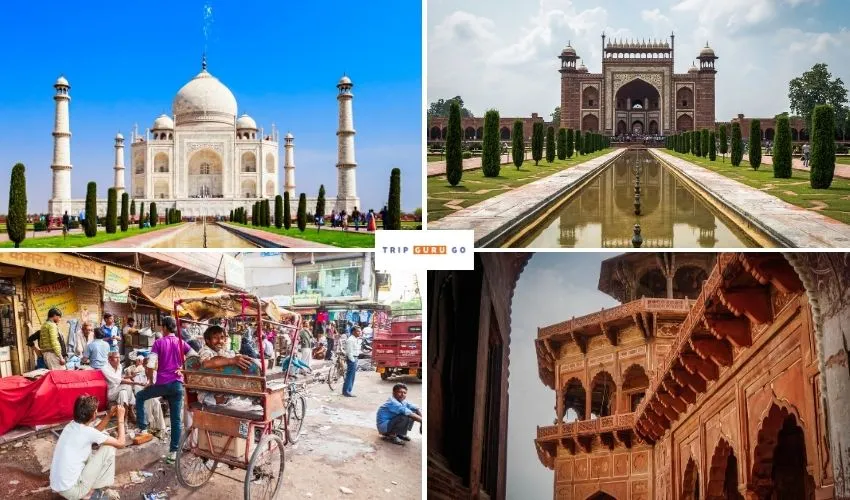
The Taj Mahal is a symbol of India’s rich heritage and one of the most famous historical places in India. This beautiful white marble mausoleum is a stunning example of Mughal architecture. Emperor Shah Jahan built it in memory of his beloved wife, Mumtaz Mahal. The construction took place in the 17th century, a time when the Mughal Empire was at its cultural and artistic peak.
The Taj Mahal reflects the empire’s wealth and global influence. It is one of the Seven Wonders of the World and a UNESCO World Heritage Site. Its intricate carvings, Persian-style symmetrical gardens, and timeless beauty make it unique as one of the best heritage sites in India.
Visiting the Taj Mahal at sunrise or sunset is magical. The changing light makes the monument look different at every moment. It reminds us that true beauty and love are eternal while time moves on.
- Ideal Season for a Visit: October to March.
- Entry Fee: ₹50 for Indian citizens.
- Nearest Airport: Agra Airport (13 km).
Tip: Visit the monument covered in soft, golden light during sunrise or sunset.
2. Red Fort (Delhi)
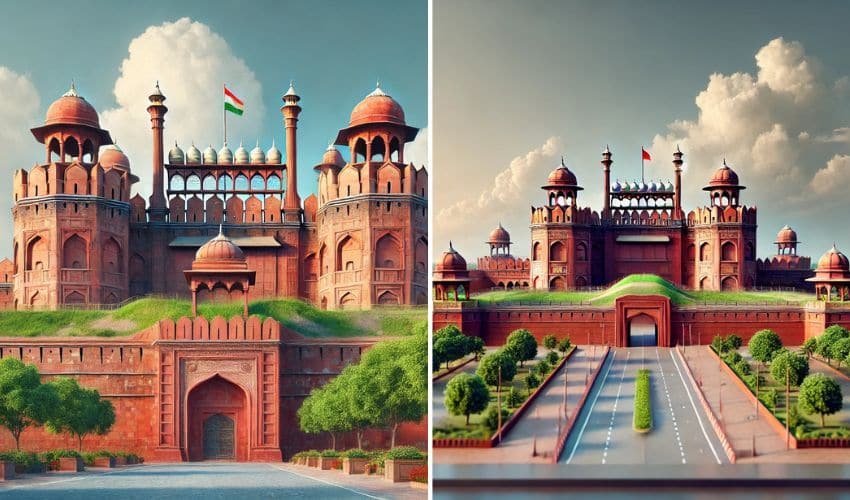
The Red Fort, also known as Lal Quila, was the main house of the Mughal emperor. Built from red sandstone, it is a remarkable example of Mughal architecture. Today, it stands as a symbol of India’s independence and is recognized as a UNESCO World Heritage Site.
The fort has several architectural highlights. The fort has two important halls. One is the Diwan-i-Aam, also called the Hall of Public Audience. The other is the Diwan-i-Khas or the Hall of Private Audience. Every year, the Prime Minister of India gives an Independence Day speech from this historic place. It is one of the famous historical places in India. It is also a must-visit destination for tourists exploring historical landmarks in India.
- Best Time to Visit: October to March.
- Entry Fee: ₹35 for Indian citizens.
- Nearest Airport: Indira Gandhi International Airport.
Highlight: Don’t miss the evening Sound and Light Show, narrating the fort’s history. Explore Delhi’s rich heritage with a visit to Purana Qila, stroll through the serene Lodhi Garden, and uncover the mysteries of Agrasen ki Baoli, all iconic landmarks that reflect the city’s fascinating history.
3. Qutub Minar (Delhi)
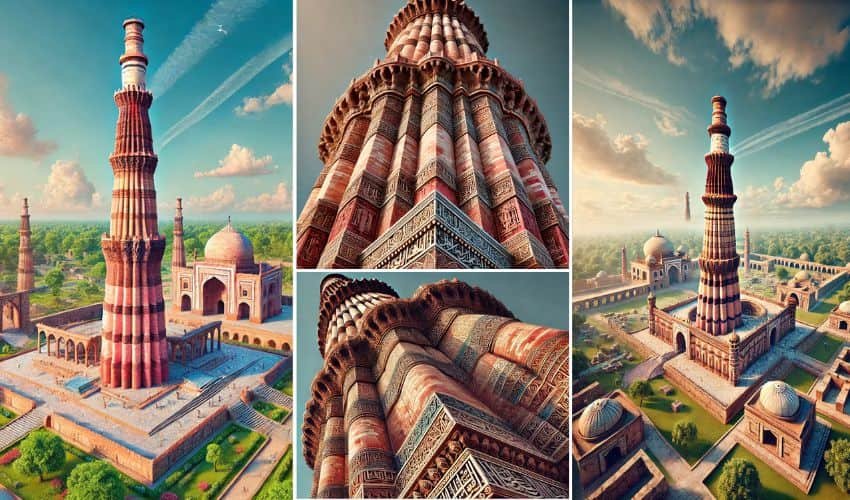
The Qutub Minar showcases the beauty of Indo-Islamic architecture. Builders constructed this 73-meter tall tower in the 12th century. This UNESCO World Heritage Site highlights Delhi’s rich history and is one of the most famous historical places in India.
Historic structures, like the Quwwat-ul-Islam Mosque, surround the tower. Its intricate carvings and inscriptions attract history lovers and architecture enthusiasts. The Qutub Minar is a must-visit for anyone exploring historical landmarks in India. It offers a great opportunity to experience Indo-Islamic architecture.
- Best Time to Visit: October to March.
- Entry Fee: ₹40 for Indian citizens.
- Nearest Airport: Indira Gandhi International Airport.
Did You Know? It is surrounded by the famous Qutub Complex which has the Iron Pillar which is known for its rust-resistant composition.
4. Amber Fort (Jaipur)
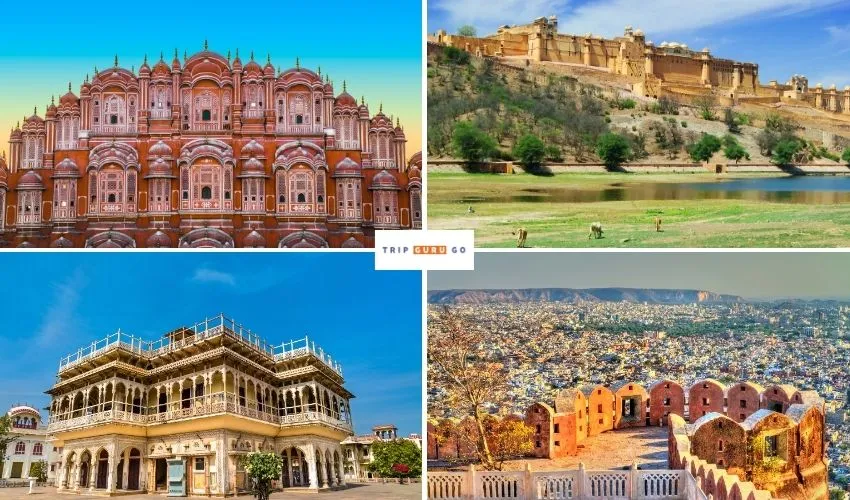
Amber Fort stands on a hilltop and offers stunning views of Maota Lake in peaceful surroundings. Raja Man Singh I built this magnificent fortress in the 16th century. The fort combines Rajput and Mughal architecture styles, making it one of the most famous historical places in India.
Inside the fort, the Sheesh Mahal dazzles with its intricate mirrorwork. The palaces and gates feature detailed carvings, and the courtyards are expansive. Every corner of the fort showcases the royal grandeur of Rajasthan’s heritage, making it a top heritage site in India. The panoramic view of the surrounding landscape adds to its beauty. Amber Fort is a must-see for anyone exploring historic landmarks in India. It is also a great place to discover Indian architectural wonders.
- Ideal Season for a Visit: October to March.
- Entry Fee: ₹100 for Indian citizens.
- Nearest Airport: Jaipur International Airport (20 km).
- Highlight: The Sound and Light Show in the evening beautifully recounts the history of Amber Fort, bringing its glorious past to life.
Tip: For a unique and royal experience, take an elephant ride up to the fort, or for a more convenient ascent, opt for a jeep ride.
5. Hampi (Karnataka)
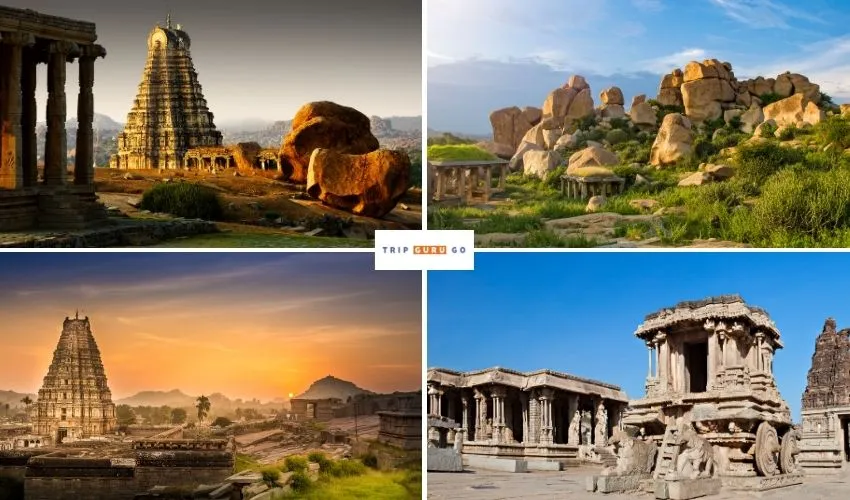
Hampi was once the royal seat of the Vijayanagara Empire. Today, it is a UNESCO World Heritage Site filled with ancient temples, royal complexes, and lively marketplaces. It is one of the most famous historical landmarks in India and attracts visitors who are keen to explore heritage sites in India.
Some must-visit attractions in Hampi include:
- Virupaksha Temple: Known for its spiritual significance and stunning architecture.
- Vijaya Vittala Temple: Famous for its iconic stone chariot and musical pillars.
Hampi’s unique landscape, covered with giant boulders, adds to its magical charm. The combination of history and natural beauty makes Hampi unforgettable. It showcases the best of Indian cultural heritage.place to visit.
- Best Time to Visit: October to March.
- Entry Fee: ₹10 for Indian citizens.
- Nearest Airport: Hubli Airport (166 km).
Unique Feature: The Vittala Temple’s musical pillars produce music when tapped.
6. Varanasi Ghats (Uttar Pradesh)
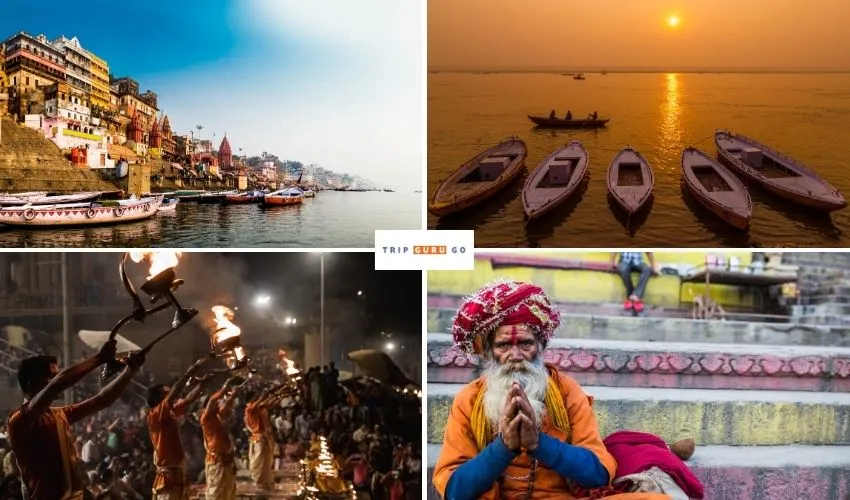
Varanasi is one of the world’s oldest continuously inhabited cities. It is famous for its iconic ghats along the River Ganga, making it one of the top historical destinations in India. These ghats are spiritual hubs where visitors can experience daily rituals and ceremonies.
The Ganga Aarti is a mesmerizing spectacle performed every evening at the Dashashwamedh Ghat. Nowhere else will you find such a deeply spiritual and vibrant experience. The city has narrow alleys, ancient temples, and a rich cultural atmosphere, making it one of the best heritage sites in India. Varanasi offers a unique look into ancient Indian history and culture. It is a must-visit for anyone interested in exploring historic landmarks in India.
- Best Time to Visit: October to March.
- Entry Fee: Free (some ceremonies may charge for seating).
- Nearest Airport: Lal Bahadur Shastri International Airport (25 km).
- Highlight: Don’t miss the evening Ganga Aarti at Dashashwamedh Ghat for a truly unforgettable spiritual experience.
Tip: For breathtaking views of the ghats and the city’s historic skyline, take a boat ride at sunrise.
7. Khajuraho Temples (Madhya Pradesh)
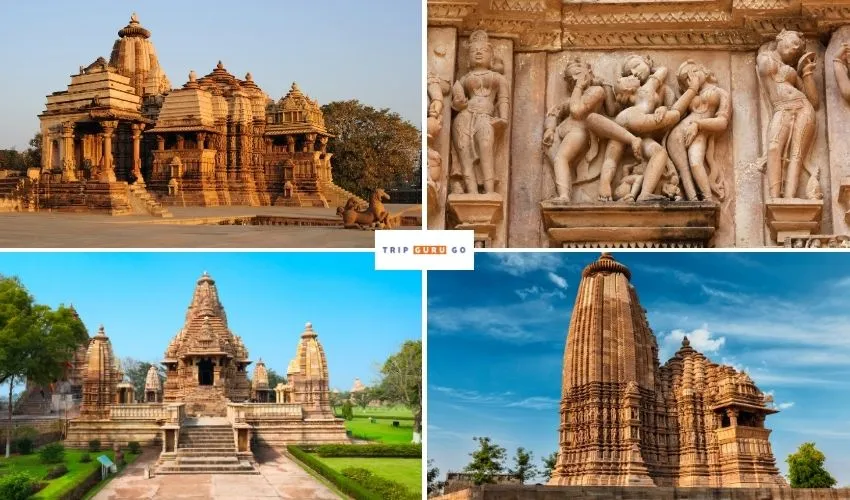
The Khajuraho Temples are famous for their beautiful carvings and unique sculptures. These temples celebrate human emotions, art, and spirituality. They are among the top historical attractions in India. The temples are excellent examples of the Chandela dynasty’s architectural legacy. They are also recognized as UNESCO World Heritage Sites.
They divide the temples into three groups:
- Western Group: These are the largest temples and the most visited, showcasing remarkable Indian craftsmanship.
- Eastern Group: These smaller but beautifully designed temples reflect the richness of ancient Indian historical places.
- Southern Group: These temples have unique styles and features. They represent the diverse cultural sites in India.
Each group is unique and shows incredible craftsmanship. A visit to Khajuraho is like stepping into a world of art, history, and Indian cultural heritage.
- Best Time to Visit: October to March.
- Entry Fee: ₹40 for Indian citizens.
- Nearest Airport: Khajuraho Airport.
Unique Feature: Experiences of both the divine and humankind are depicted by the sculptures.
8. Victoria Memorial (Kolkata)
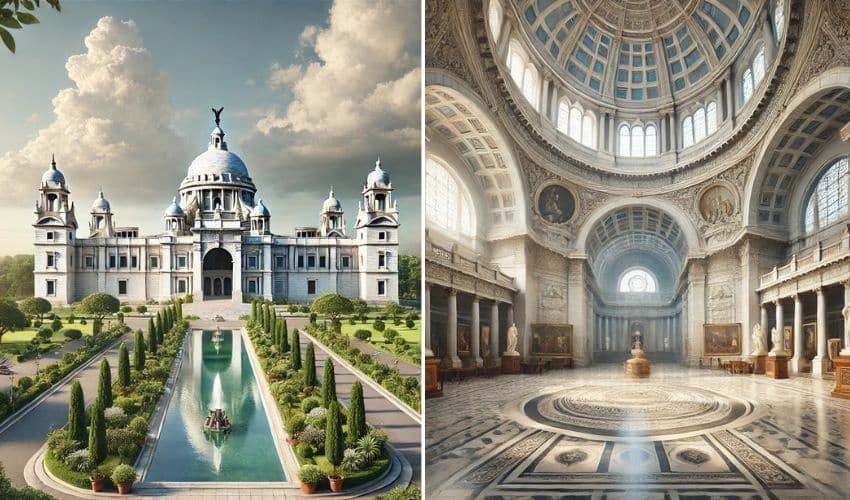
The Victoria Memorial stands in the heart of Kolkata. The British constructed this grand structure during the colonial era. It combines elements of European and Mughal architecture, making it truly unique. It is one of the most famous historical landmarks in India.
Inside, the museum offers a glimpse into life during colonial India. The gardens surrounding the memorial offer a peaceful escape from the busy city. It is a perfect spot to enjoy Indian heritage sites. A visit to this iconic landmark is relaxing and educational. It provides insights into India’s colonial history.
- Ideal Season for a Visit: November to February.
- Entry Fee: ₹30 for Indian citizens.
- Nearest Airport: Netaji Subhash Chandra Bose International Airport.
Pro Tip: Visit in the evening for the Sound and Light Show.
9. Golconda Fort (Hyderabad)
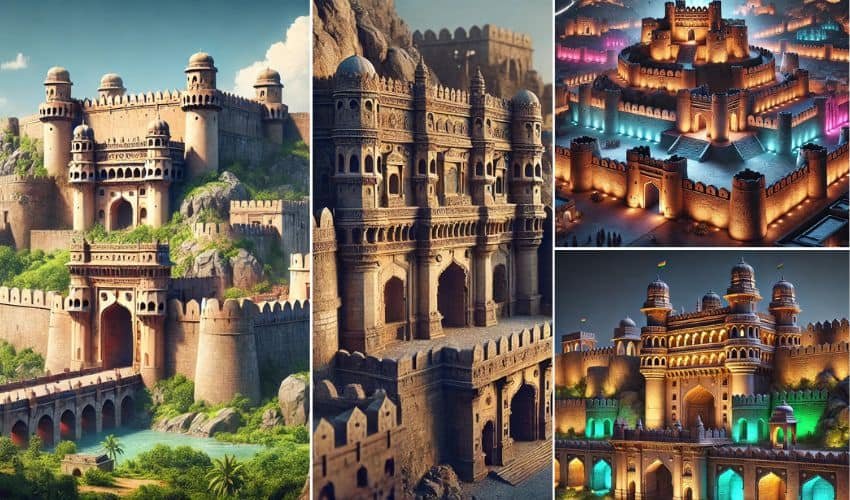
Golconda Fort is a historical gem that tells the story of the Qutb Shahi dynasty. It reflects their grand vision, brilliant engineering, and beautiful architecture, making it one of the top historical landmarks in India. The Qutb Shahi rulers built the fort in the 16th century and made it their capital. It also played an important role in regional politics, cementing its place as a key heritage site in India.
The fort is famous for its unique acoustic system. If you clap at the entrance, the sound travels to the highest point of the fort. This clever design acted as an ancient security measure. Visitors who climb to the top are rewarded with stunning views of Hyderabad. The fort showcases the natural beauty of Indian historical sites. Golconda Fort combines history and nature. It is a must-visit destination for anyone exploring Indian cultural heritage.
- Best Time to Visit: October to March.
- Entry Fee: ₹20 for Indian citizens.
- Nearest Airport: Rajiv Gandhi International Airport (30 km).
Tip: Visit in the evening to catch the Sound and Light Show, which captures the fort’s history in a captivating way.
10. Mysore Palace (Mysore)
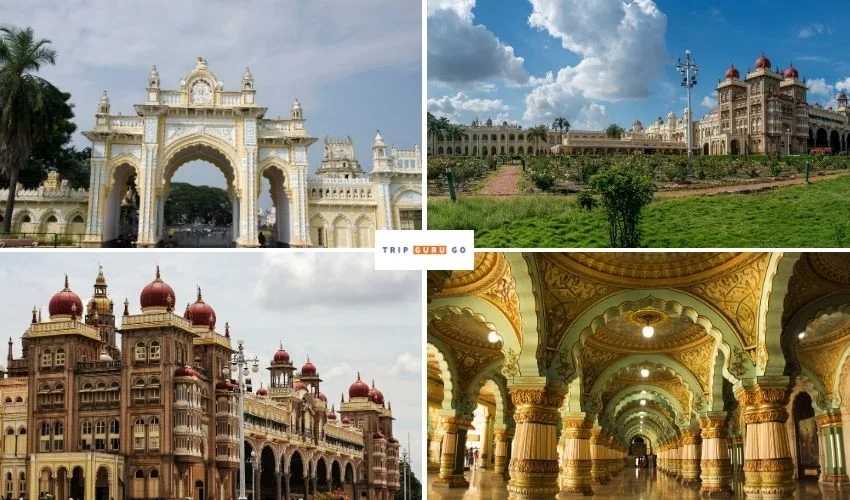
The Mysore Palace is a symbol of royal beauty and history. It showcases intricate details and vibrant colors and reflects the legacy of the Wodeyar dynasty, making it one of the most famous historical places in India.
During the Dussehra festival, the palace lights up with thousands of bulbs. This creates a breathtaking and magical spectacle that draws visitors from around the world. It makes the palace a must-visit heritage site in India. The grandeur of the palace is a perfect example of Indian architectural wonder. Its cultural significance also highlights India’s rich heritage.
- Best Time to Visit: October to March.
- Entry Fee: ₹70 for Indian citizens.
- Nearest Airport: Mysore Airport (12 km).
Tip: Plan your visit during the Mysore Dasara festival to experience an unforgettable celebration.
11. Fatehpur Sikri (Uttar Pradesh)
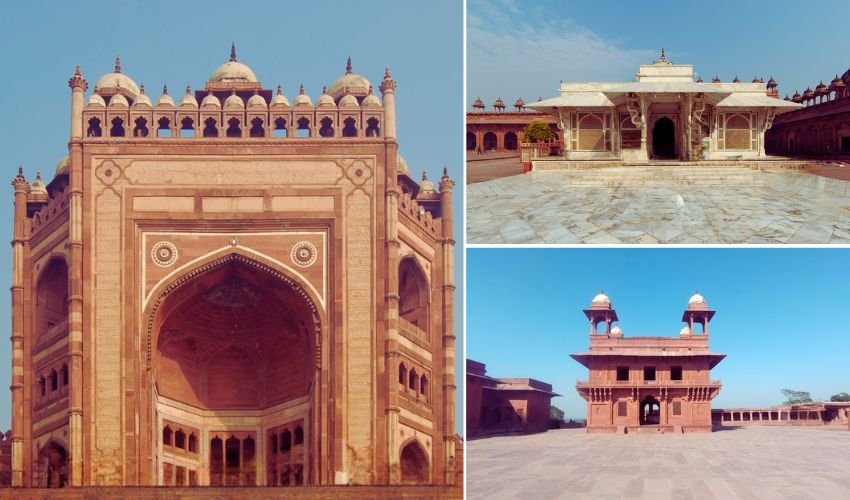
Fatehpur Sikri was Emperor Akbar’s temporary capital. It represents his vision and artistic taste, showcasing the Mughal style of architecture. Akbar built this remarkable city in the late 16th century. It is one of the most significant historical landmarks in India.
Key features of Fatehpur Sikri include:
- Buland Darwaza: This grand archway symbolizes Akbar’s military victories and reflects the grandeur of Mughal architecture.
- Panch Mahal: It is a five-storied palace with beautifully carved columns. The palace blends Persian, Indian, and Islamic styles. It is a fine example of Indian cultural heritage.
This cultural and historical landmark is a masterpiece of the Mughal era. It is a must-visit for history lovers and anyone interested in Indian heritage sites.
- Best Time to Visit: October to March.
- Entry Fee: ₹40 for Indian citizens.
- Nearest Airport: Agra Airport (36 km).
Tip: Visit early in the morning to avoid crowds and enjoy the serenity of the site.
12. Mamallapuram (Tamil Nadu)
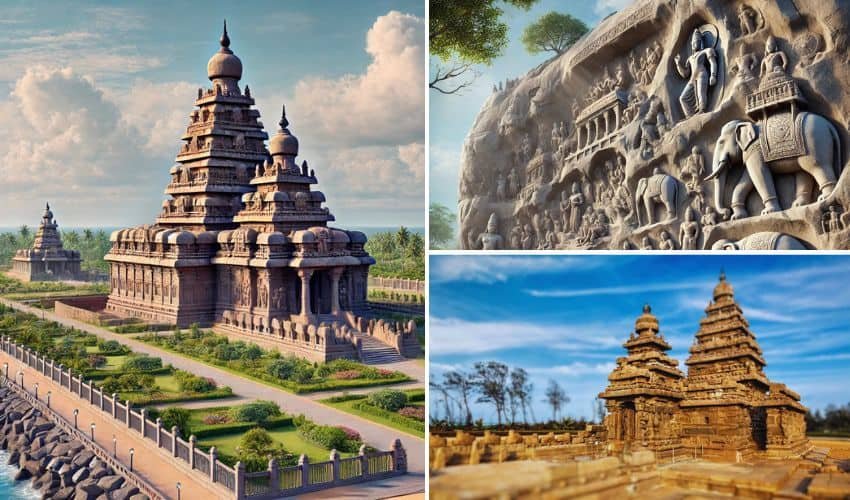
This UNESCO World Heritage Site highlights the incredible artistry of the Pallava dynasty. It is famous for the Shore Temple, Arjuna’s Penance, and the Five Rathas, making it one of the most significant historical landmarks in India.
- Shore Temple: The Shore Temple sits on the coast of the Bay of Bengal and features intricate carvings of gods and mortals. These carvings reflect the Indian architectural wonders of the time.
- Arjuna’s Penance: This open-air rock relief details myths and moral stories and showcases ancient Indian historical places through art.
- Five Rathas: These monolithic stone structures resemble chariots. They show innovative designs and represent heritage sites in India.
Each of these landmarks showcases ancient Indian craftsmanship. They are a must-visit for anyone interested in Indian cultural heritage.
- Best Time to Visit: November to February.
- Entry Fee: ₹40 for Indian citizens.
- Nearest Airport: Chennai International Airport (57 km).
Tip: The best time to explore the site is early morning or late afternoon when there is good lighting and relatively few people.
13. Humayun’s Tomb (Delhi)
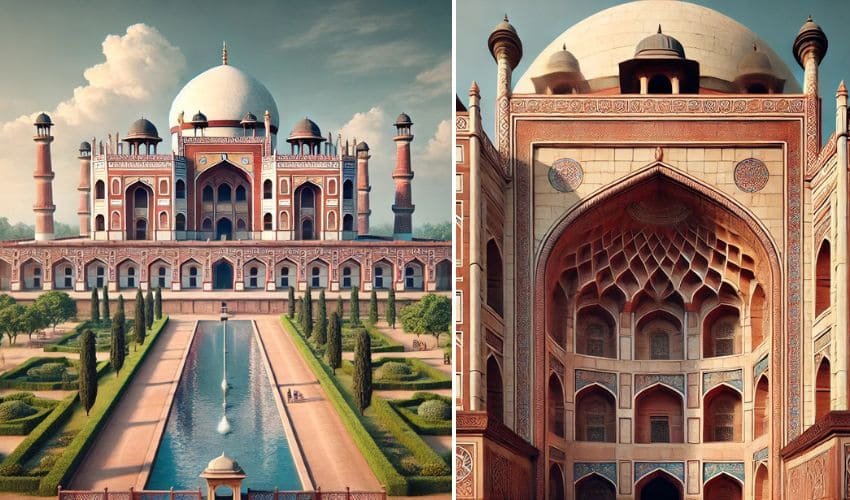
Humayun’s Tomb inspired the Taj Mahal. It is a stunning blend of Persian and Indian architectural styles, establishing it as one of the most significant historical landmarks in India. The tomb is surrounded by carefully designed Charbagh gardens, which add to its charm and enhance its beauty.
Built-in 1570, Humayun’s Tomb was the first garden tomb in the Indian subcontinent. It set the standard for future Mughal architectural masterpieces. This makes it a must-visit heritage site in India. The tomb showcases the remarkable craftsmanship of the Mughal era. It is also a prime example of India’s rich cultural heritage.
- Ideal Season for a Visit: October to March.
- Entry Fee: ₹40 for Indian citizens.
- Nearest Airport: Indira Gandhi International Airport (22 km).
Tip: Seeing it at sunrise or sunset assures a more peaceful experience, and the views are stunning.
14. Charminar (Hyderabad)
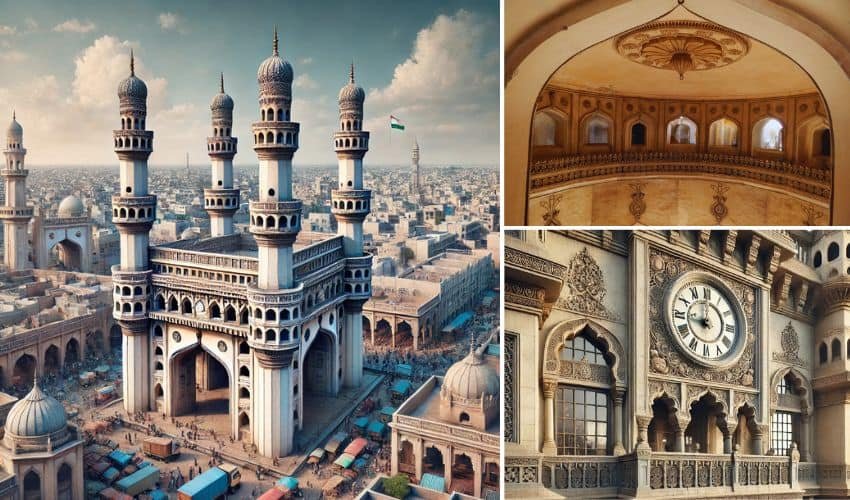
The Charminar is a timeless symbol of Hyderabad’s cultural heritage. This iconic structure is surrounded by busy bazaars that sell traditional Hyderabadi goods, making the Charminar one of the most famous historical places in India.
Sultan Muhammad Quli Qutb Shah built the Charminar in 1591 to mark the end of a devastating plague outbreak in the city. The Charminar is a remarkable example of Indo-Islamic architecture. It showcases the creativity and skill of the period. It is a must-visit heritage site in India. The Charminar offers a glimpse into Hyderabad’s rich history and culture.
- Best Time to Visit: November to February.
- Entry Fee: ₹20 for Indian citizens.
- Nearest Airport: Rajiv Gandhi International Airport (20 km).
Tip: Visit during the evening to enjoy the illuminated monument and nearby bustling Laad Bazaar.
15. Jantar Mantar (Jaipur)
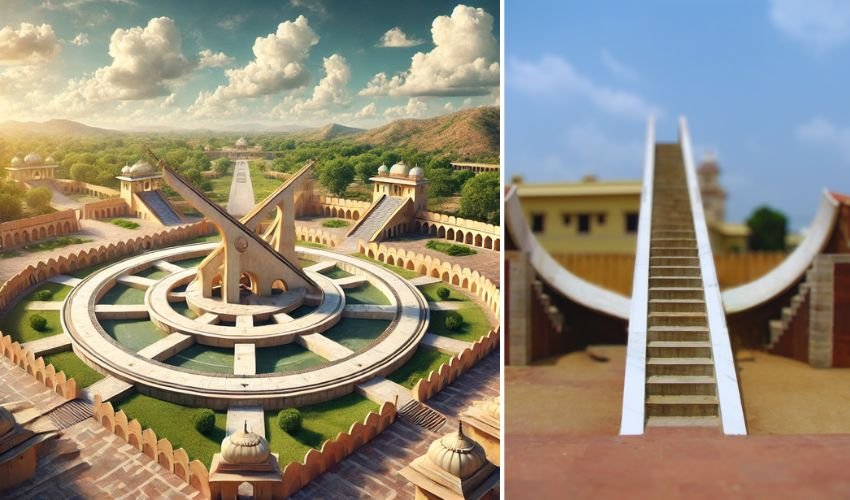
Jantar Mantar is a fascinating place that blends science, art, and spirituality. Maharaja Jai Singh II built it to study the stars and planets. This famous historical place in India is one of the most unique astronomical landmarks. It showcases the scientific ingenuity of the time.
The site features large instruments that were used for astronomical observations. Jantar Mantar is a great example of India’s early advancements in science and architecture. It is a must-visit for those interested in Indian cultural heritage and famous historical places in India.
- Best Time to Visit: October to March.
- Entry Fee: ₹50 for Indian citizens.
- Nearest Airport: Jaipur International Airport (13 km).
Tip: Get a guide to understand the scientific tools and their history better.
16. Ajanta and Ellora Caves (Maharashtra)
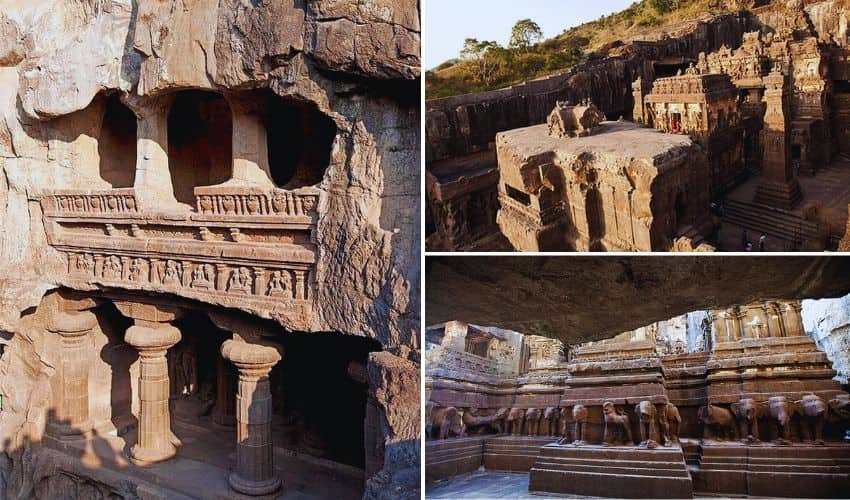
These caves are famous for their ancient Buddhist frescoes and carvings. They are recognized as a UNESCO World Heritage Site and highlight India’s rich artistic and spiritual traditions. The caves are among India’s most significant historical landmarks.
The walls of the caves depict the vibrant Jataka tales, showing the life of Buddha. Intricate motifs reflect the culture and religion of that time. Each cave is a masterpiece showcasing the artisans’ skill. It is a must-visit heritage site in India for those interested in Indian cultural heritage.
- Best Time to Visit: June to March.
- Entry Fee: ₹40 for Indian citizens.
- Nearest Airport: Aurangabad Airport.
Must-See: Carved out of a single rock, the Kailasa Temple at Ellora.
17. Sun Temple (Konark)
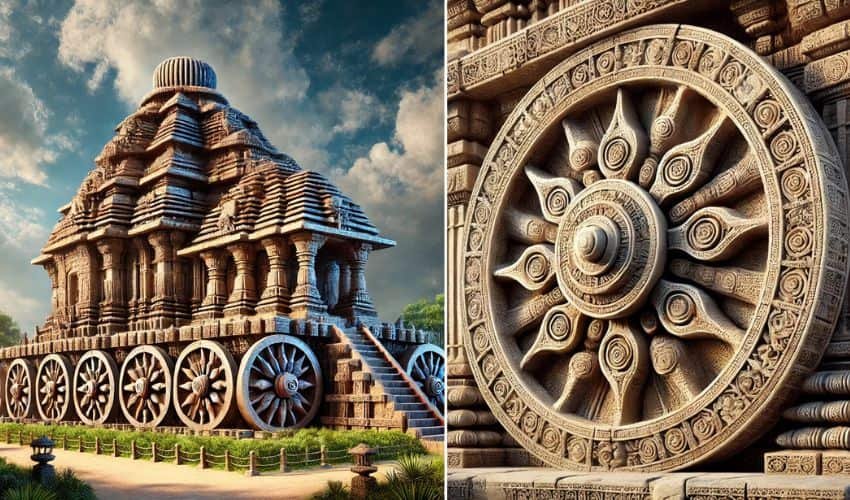
The Sun Temple in Konark, Odisha, is a magnificent structure dedicated to Surya, the Sun God. It is built like a giant chariot with 24 carved wheels. These wheels represent the passing of time. This makes it one of the most famous historical places in India.
The temple’s walls have carvings of gods, animals, and stories from mythology. This heritage site in India showcases the artistic brilliance of ancient Indian artisans. Known as the Black Pagoda, it continues to awe visitors with its beauty and history. The Sun Temple is a must-visit for anyone interested in Indian architectural wonders. It is also one of India’s most significant historical landmarks.
- Best Time to Visit: November to February.
- Entry Fee: ₹40 for Indian citizens.
- Nearest Airport: Biju Patnaik International Airport, Bhubaneswar (65 km).
- Highlight: The intricate carvings on the temple’s wheels and walls are a testament to the advanced engineering and artistry of its time.
Tip: Visit the Konark Dance Festival in December for a blend of cultural and historical experiences.
18. Chittorgarh Fort (Rajasthan)
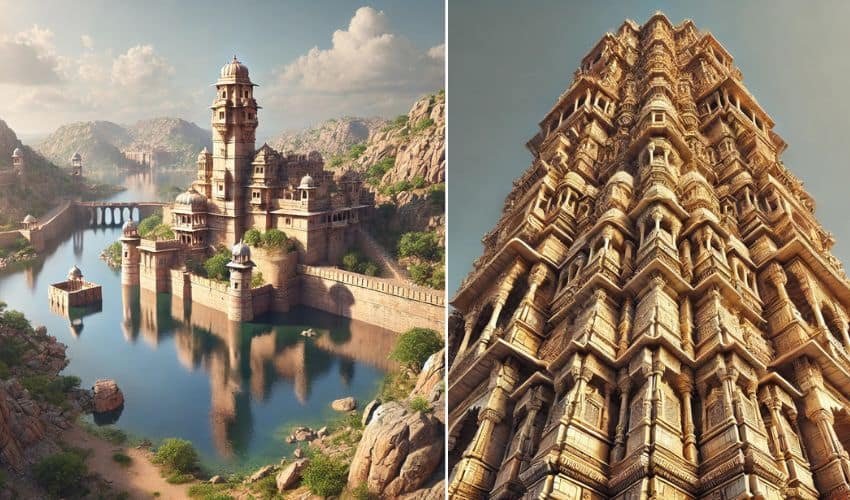
Chittorgarh Fort is the largest fort in India and a symbol of Rajput courage and bravery. This UNESCO World Heritage Site boasts stunning palaces, temples, and intricate carvings that showcase the architectural brilliance of the Rajput era, establishing it as one of India’s most significant heritage sites.
Some key attractions within the fort include:
- Vijay Stambh (Victory Tower): A monument celebrating Rajput victories and their rich history.
- Kirti Stambh (Tower of Fame): It is a beautiful structure that honors Jain traditions. It also showcases ancient Indian architectural style.
- Rana Kumbha Palace: This historic palace is known for its grand design, which reflects the royalty and culture of the Rajput era.
- Padmini Palace: A place famous for its connection to Rani Padmini’s legacy, adding to the cultural heritage of Rajasthan.
The fort’s walls and vast courtyards tell stories of its rich history and the bravery of its sieges. This is a must-visit historical destination in India, where visitors can explore Indian architectural wonders and cultural landmarks.
- Suggested Travel Period: October to March.
- Entry Fee: ₹50 for Indian citizens.
- Nearest Airport: Maharana Pratap Airport, Udaipur.
Tip: Join a guided tour of the fort to explore its rich history and uncover the fascinating legends associated with it.
19. Rani ki Vav (Gujarat)
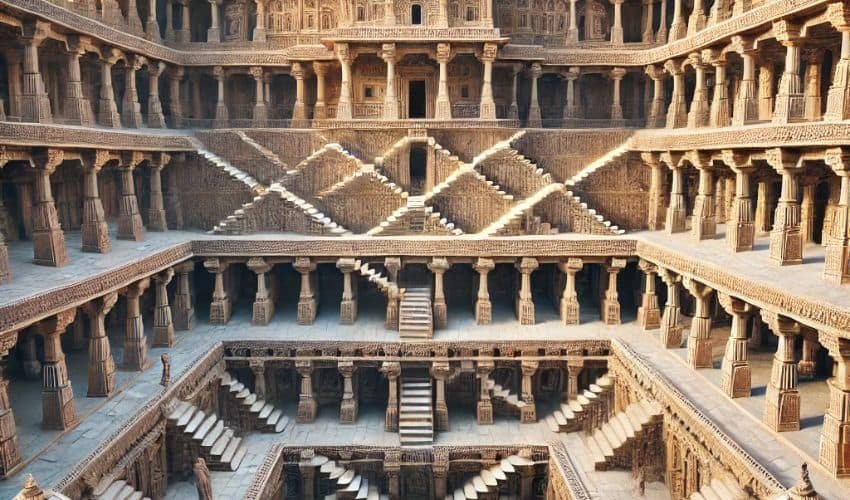
Rani ki Vav is an ancient stepwell that reflects the brilliance of Solanki dynasty architecture. Queen Udayamati built it in the 11th century to honor her husband, King Bhimdev I. It was not only a water storage system but also a stunning work of art. As a result, it has become one of the most remarkable historical landmarks in India.
This stepwell has seven levels with over 500 detailed sculptures. These carvings depict Hindu gods, mythological stories, and scenes from daily life. The intricate craftsmanship highlights the cultural importance of water as a life-giving force. It showcases the artistic and architectural brilliance of ancient Indian heritage sites. Rani ki Vav is a must-visit for anyone interested in Indian cultural heritage and historical places in India.
- Best Time to Visit: November to February.
- Entry Fee: ₹20 for Indian citizens.
- Nearest Airport: Ahmedabad Airport.
Tip: Admire the intricate carvings of Lord Vishnu in various forms, such as Kalki and Rama, which highlight the site’s spiritual significance.
20. Hawa Mahal (Jaipur)
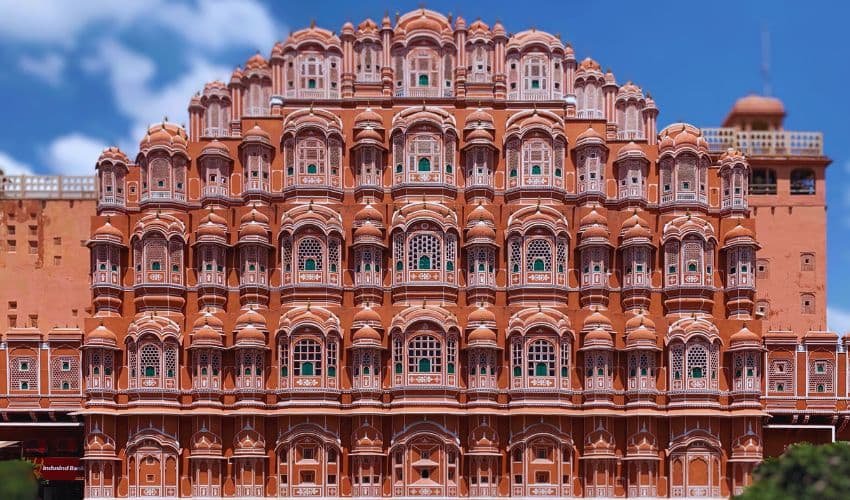
Maharaja Sawai Pratap Singh constructed the Hawa Mahal, famously known as the ‘Palace of Winds,’ in 1799. This five-story structure is located in the heart of Jaipur. It is made of pink sandstone and shaped like a crown. This makes it one of the most iconic historical landmarks in India.
The palace features an intricate ventilation system that, as a result, keeps the interiors cool and airy even during Jaipur’s intense summers. Moreover, in the past, royal women utilized its design to discreetly observe festivals and street life while adhering to the purdah system. The front of the palace looks like a honeycomb, making it unique and beautiful. Hawa Mahal is a must-visit heritage site in India. It is perfect for those interested in Indian architectural wonders and historical places.
- Best Time to Visit: October to March.
- Entry Fee: ₹50 for Indian citizens.
- Nearest Airport: Jaipur International Airport.
Highlight: From the top, enjoy panoramic views of Jaipur’s busy street life and famous landmarks like Jantar Mantar and City Palace.
21. Elephanta Caves (Mumbai)
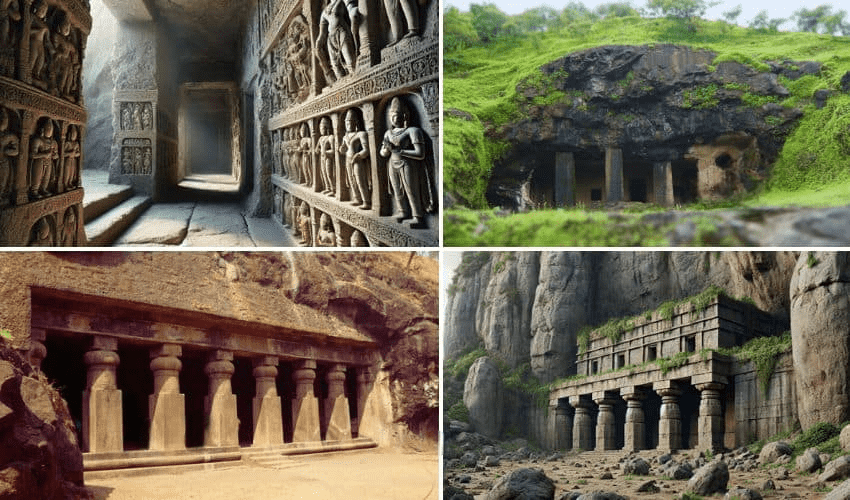
The Elephanta Caves sit on Elephanta Island near Mumbai. Ancient artisans carved these rock-cut caves between the 5th and 8th centuries AD. UNESCO recognizes them as World Heritage Sites, making them one of the most significant historical places in India.
The caves are dedicated to Lord Shiva and beautifully reflect a blend of Hindu and Buddhist influences. The 20-foot-tall Trimurti sculpture depicts Shiva in three forms: the creator, preserver, and destroyer. These sculptures display the artistic brilliance and craftsmanship of ancient India. The Elephanta Caves are a must-visit heritage site in India. They are perfect for those interested in exploring Indian cultural heritage and historical landmarks.
- Suggested Travel Period: October to March.
- Entry Fee: ₹40 for Indian citizens.
- Nearest Airport: Chhatrapati Shivaji International Airport.
Tip: The ferry to the island departs from the Gateway of India in Mumbai. Don’t miss the lush greenery and panoramic sea views along the way.
22. Orchha (Madhya Pradesh)
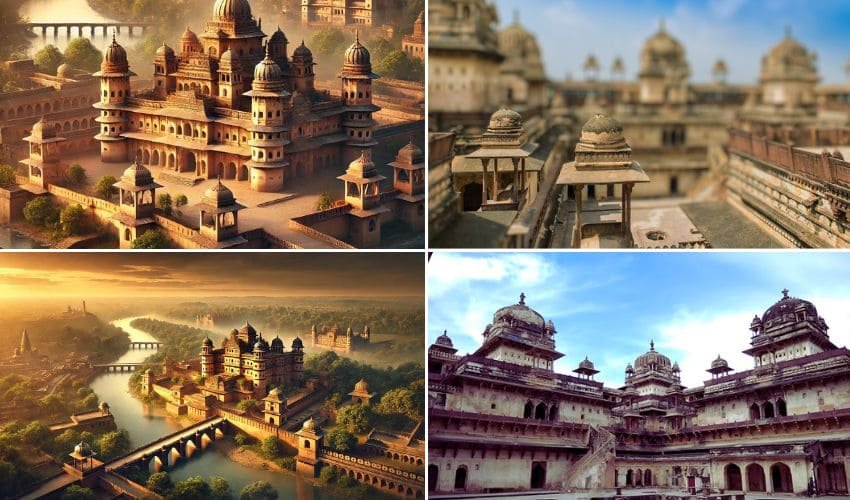
Orchha is a small historical town on the banks of the Betwa River. It is famous for its beautiful palaces, temples, and chhatris. Bundela Rajput Chief Rudra Pratap Singh founded the town in the 16th century, establishing it as one of the most significant historical places in India.
The main attractions in Orchha include:
- Orchha Fort Complex: It features Jehangir Mahal, known for its stunning latticework. The palace offers panoramic views of the Betwa River.
- Ram Raja Temple: The temple worships Lord Rama as a king, making it unique. It showcases the rich Indian cultural heritage.
- Chaturbhuj Temple: It is known for its tall spires and fascinating design. The temple reflects the architectural wonders of ancient India.
Orchha’s historical charm and unique architecture make it a must-visit destination. It is perfect for anyone exploring Indian heritage sites and historical landmarks.
- Best Time to Visit: October to March.
- Entry Fee: ₹10 for Indian citizens.
- Nearest Airport: Gwalior Airport.
Tip: Enjoy a leisurely boat ride on the Betwa River to see Orchha’s magnificent cenotaphs and temples in beautiful silhouettes against the sky.
Additional Gems Among Famous Historical Places in India
1. Gol Gumbaz, Karnataka
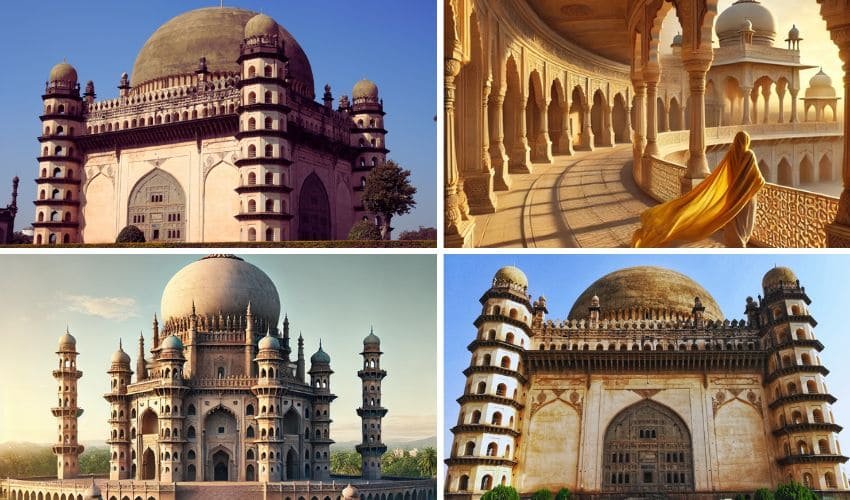
Gol Gumbaz in Bijapur, Karnataka, stands out for its incredible architecture. It has one of the largest domes in the world, making it one of the most iconic heritage sites in India.
The structure is famous for its whispering gallery, a remarkable feature of acoustic engineering. Even the softest sounds travel across the dome, showcasing the brilliance of ancient Indian architectural wonders. This unique quality makes Gol Gumbaz a must-visit. It is perfect for anyone interested in Indian cultural landmarks.
- Best Time to Visit: October to March.
2. Nalanda, Bihar
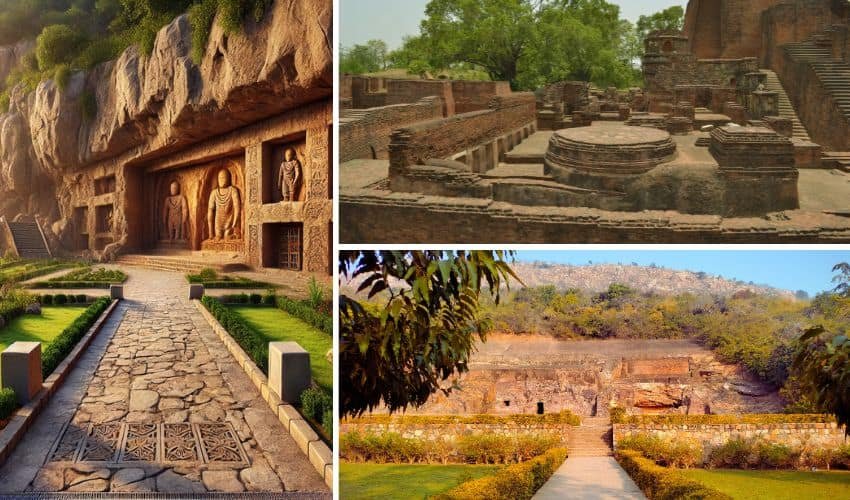
Nalanda was a center of learning in ancient India. One of the world’s first universities was located there. It made significant contributions to Buddhist studies, science, and philosophy, establishing itself as one of the most renowned historical places in India.
At its peak, Nalanda attracted scholars from all over Asia who came to gain knowledge. Today, the ruins of Nalanda reveal its rich history. The halls, libraries, and monasteries were carefully built to promote learning and knowledge. They showcase the architectural brilliance of ancient India. Nalanda is a must-visit historical site in India for anyone interested in exploring Indian cultural heritage and historical landmarks.
- Best Time to Visit: October to March.
3. Meenakshi Temple, Tamil Nadu
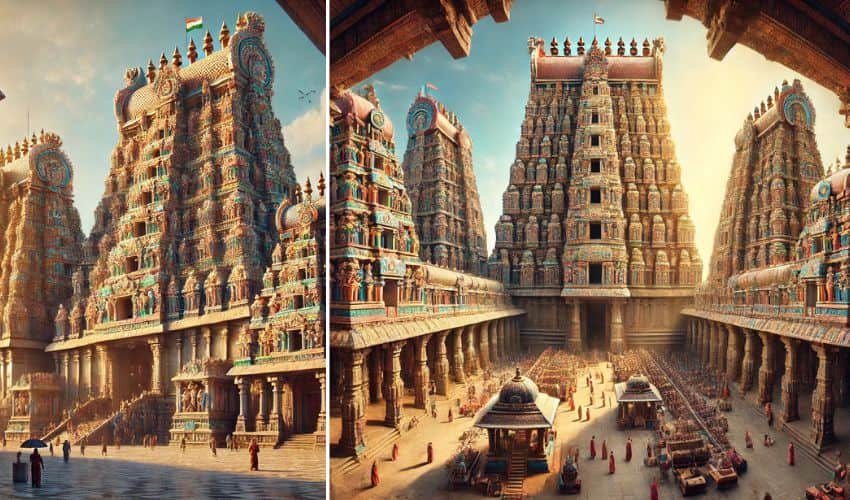
The Meenakshi Temple is famous for its colorful gopurams (tower gates). These towers rise high and are covered with vibrant sculptures of mythological stories. These structures are iconic examples of Dravidian architecture, making them some of the most significant historical places in India.
Inside the temple, the Hall of Thousand Pillars stands as a masterpiece of stonework and artistry. It showcases the brilliance of ancient Indian craftsmanship. The temple is dedicated to Goddess Meenakshi and Lord Sundareswarar. Every year, millions of devotees and tourists visit to experience its beauty and spiritual significance. It is a must-visit heritage site in India for those interested in Indian cultural heritage and historical landmarks.
- Best Time to Visit: October to March.
Travel Tips for Exploring Famous Historical Places in India
- Sustainable Tourism: Respect the environment and local culture throughout your visit to promote sustainable tourism. Avoid littering and choose eco-friendly options.
- Best Time to Visit: Plan your trip between October and March, as the weather during this period is pleasant and ideal for travel.
- Tickets: Book your tickets online to skip long queues.
- Local Guides: Hire knowledgeable guides for detailed insights into temples and historical sites.
- Dress Code: Ensure you wear modest clothing when visiting religious places to show respect for local traditions.
- Photography: Check if photography is allowed, as some sites have restrictions.
- Accessibility: Look for wheelchair access and facilities if needed.
Personal Travel Experiences of Famous Historical Places in India
Exploring India’s historical landmarks has been an unforgettable journey. I was captivated as the Taj Mahal’s marble reflected stunning gold and pink hues at sunrise, a sight I will never forget. It is one of the most iconic historical places in India. The intricate mirror work of the Sheesh Mahal in Amber Fort, Jaipur, showcased the brilliance of Rajput architecture. It is a perfect example of Indian architectural wonders. Visiting the ghats of Varanasi left me with a profound spiritual connection that continues to resonate within me. It highlights the cultural significance of Indian heritage sites.
In Hampi, the ancient ruins and surreal boulder landscapes transported me back to the grandeur of the Vijayanagara Empire. Each site has its own story, carved in stone, waiting to be uncovered. These monuments remind us of India’s rich and glorious past. They strengthen our connection to it, making them a must-visit heritage site in India. They are perfect for anyone interested in Indian cultural heritage and historical landmarks in India.
Conclusion
In conclusion, India’s famous historical places reflect the nation’s rich and diverse heritage. These heritage sites showcase the country’s unique history. The Taj Mahal’s beauty and the peaceful atmosphere of Varanasi reveal India’s rich past. These places offer a glimpse into the country’s glorious history. Whether you are a history enthusiast or a passionate traveler, visiting these destinations will surely inspire you.
Start planning your journey and explore India’s cultural treasures. Let them take you through centuries of culture and tradition. Which of these amazing historical sites in India will you visit first? Begin your adventure today and share your favorite Indian heritage sites. These timeless monuments will inspire your next journey into India’s cultural beauty.
FAQs
Yes, most historical sites are well-maintained. Authorities work to protect them and preserve their cultural and architectural importance.
Agra is well-connected to Delhi by road and rail. You can take a train, or bus, or hire a cab to reach Agra from Delhi.
Yes, you can take photos at most historical sites. However, some areas may have restrictions.
Yes, there is an entry fee for most historical sites. The fee varies for Indian and foreign tourists.
The best time to visit India for historical sightseeing is during the winter season, from October to March. The weather is pleasant and makes travel comfortable.
India is home to many incredible historical sites, but there are 10 that you cannot miss. These include the Taj Mahal, Red Fort, Qutub Minar, Amber Fort, Hampi, Varanasi Ghats, Khajuraho Temples, Victoria Memorial, Mysore Palace, and Golconda Fort. Each landmark showcases India’s stunning architecture and vibrant cultural diversity and offers a fascinating look into the country’s rich history.
Delhi is famous for its many historical monuments. Key landmarks include the Red Fort, Qutub Minar, Humayun’s Tomb, and India Gate. Known as the capital of empires, Delhi combines its ancient history with modern heritage, creating a unique blend of the past and present.
Varanasi is known as one of the most historic cities in India and one of the world’s oldest continuously inhabited cities. It is famous for its spiritual and historical landmarks, including the iconic ghats along the Ganges River and its ancient temples.
The Taj Mahal is famous for its stunning Mughal architecture and perfect symmetry. Its creation is inspired by a timeless love story. Emperor Shah Jahan built it in memory of his wife Mumtaz Mahal. This white marble masterpiece is one of the Seven Wonders of the World and a UNESCO World Heritage Site.
India’s UNESCO World Heritage Sites include the Ajanta Caves, Sun Temple, and Jaipur City. These places are known for their cultural and historical importance. They preserve India’s history and attract millions of visitors each year.
Start by researching the sites you want to visit and how close they are to each other. Book your tickets online to avoid long queues and save time. Plan your itinerary to make the most of your trip. Consider hiring a local guide to learn more about the history and culture of the places you visit. For the best weather, plan your trip between October and March.
Famous places are popular, but spots like Chittorgarh Fort, Rani ki Vav, and Mamallapuram are also great. They have beautiful designs and are less crowded, so you can enjoy them peacefully.
The best time to visit historical sites in India is between October and March. The weather is cool and nice, perfect for outdoor visits.
Respect local traditions and dress modestly when visiting religious sites. Check if photography is allowed before taking pictures. Carry water to stay hydrated and wear comfortable shoes for walking. Join a guided tour to learn more about the history of these landmarks.
References:
- UNESCO World Heritage Sites – India. (n.d.). Retrieved from https://whc.unesco.org/en/statesparties/in/





